The Ultimate Guide to Selling Jewelry Online 2024: Strategies, Tools, and Tips to Dominate the Market
 Pic Copilot Team
Pic Copilot TeamIn today's digital age, the online jewelry market is booming like never before. With the global jewelry market expected to reach $291.7 billion by 2025, there's never been a better time to take your jewelry business online. The shift towards e-commerce has opened up vast opportunities for both new and established jewelers to reach a global audience, expand their customer base, and increase sales.
Establishing an online presence for your jewelry business is crucial. Not only does it allow you to tap into a wider market, but it also provides a platform to showcase your unique designs, build your brand, and connect with customers in a more personalized and engaging way. Whether you're an independent designer or a large jewelry retailer, an effective online strategy can set you apart from the competition and drive significant growth.

What this guide will cover:
- Market Analysis: Identify your niche and understand current jewelry trends.
- Setting Up Your Online Jewelry Store: Step-by-step guide to choosing the right e-commerce platform and essential features for success.
- Sourcing Your Jewelry: Options for sourcing, ethical practices, and quality control.
- Pricing Your Jewelry: Strategies for competitive pricing and tools for pricing automation.
- Logistics and Fulfillment: Shipping options, fulfillment methods, and inventory management.
- Creating High-Quality Content and Visuals: Importance of high-quality images and descriptions, plus AI tools for image generation.
- Building a High-Impact Marketing Strategy: Social media marketing, email campaigns, content marketing, and paid advertising.
- Customer Service and Building Loyalty: Exceptional customer service tools, building loyalty programs, and utilizing customer reviews.
Let's get started on your journey to dominate the online jewelry market!
1. Why Sell Jewelry Online?
Market Potential and Trends
The online jewelry market is experiencing unprecedented growth. The global jewelry market ecommerce revenue is projected to reach $102 billion by 2025, driven by the increasing popularity of online shopping and the convenience it offers. With more consumers turning to e-commerce for their jewelry purchases, businesses have the opportunity to tap into a vast, expanding market. Key trends include:
- Personalization and Customization: Customers are seeking unique, personalized pieces that reflect their individuality.
- Sustainability and Ethical Sourcing: There is a growing demand for ethically sourced and environmentally friendly jewelry.
- Digital Shopping Experience: Enhanced online shopping experiences, including virtual try-ons and detailed product videos, are becoming the norm.
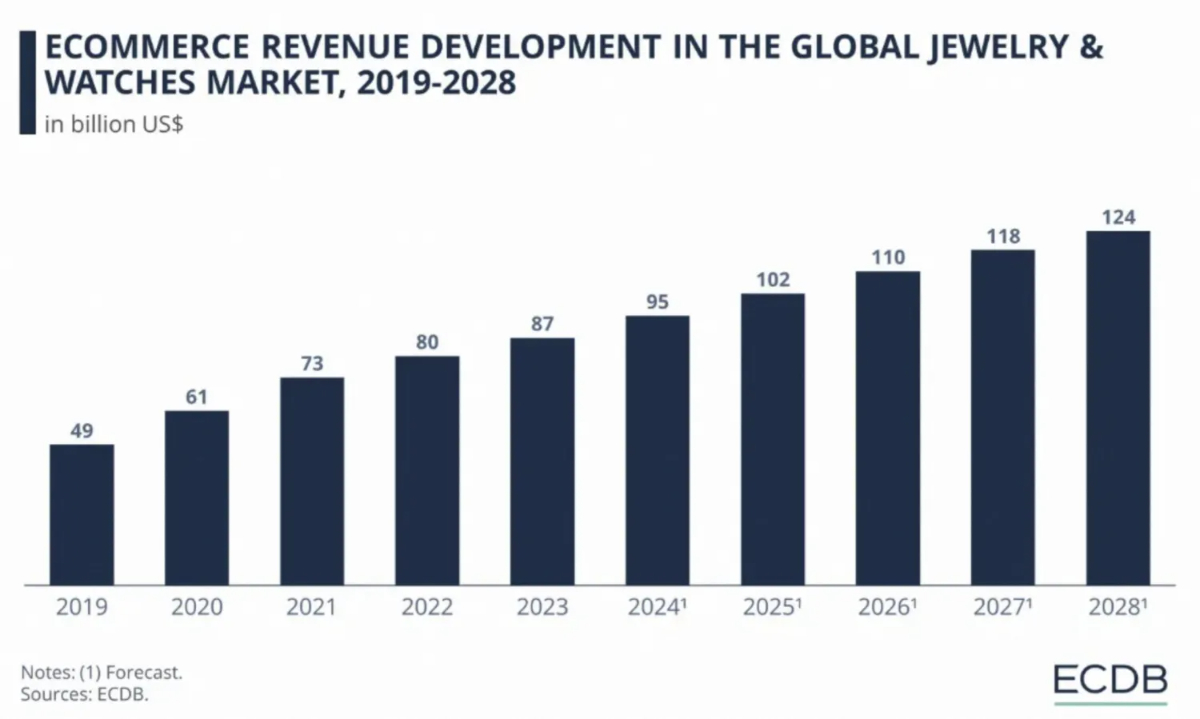
Advantages of Online vs. Offline Sales
Selling jewelry online presents numerous advantages over traditional brick-and-mortar stores:
- Wider Reach: Access a global audience, breaking geographical limitations.
- Lower Overheads: Reduce costs associated with physical storefronts, such as rent and utilities.
- Convenience: Allow customers to shop anytime, anywhere, increasing sales potential.
- Data-Driven Insights: Utilize analytics to understand customer behavior and preferences, enabling more targeted marketing strategies.
- Scalability: Easily scale your business by adding new products and entering new markets without the constraints of physical space.
Case Studies of Successful Online Jewelry Businesses
- Blue Nile: One of the pioneers in online jewelry sales, Blue Nile revolutionized the market by offering high-quality diamonds and engagement rings at competitive prices. Their success is attributed to their user-friendly website, extensive educational resources, and excellent customer service.
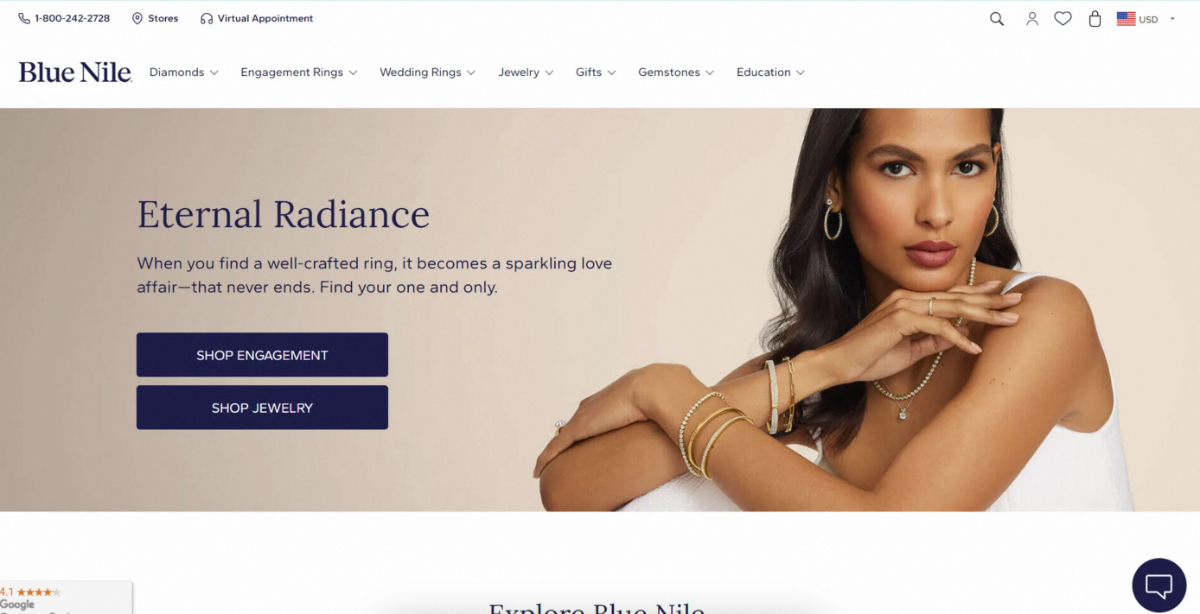
- Mejuri: Known for its "everyday fine jewelry," Mejuri has successfully built a loyal customer base through direct-to-consumer sales. Their strong social media presence and influencer collaborations have significantly boosted brand visibility and sales.
- Brilliant Earth: Specializing in ethically sourced diamonds and gemstones, Brilliant Earth has tapped into the growing demand for sustainable jewelry. Their commitment to transparency and social responsibility has resonated with consumers, driving their success.

By leveraging the advantages of online sales and learning from these successful case studies, you can position your jewelry business for growth and success in the digital marketplace.
2. Identifying Trending Jewelry Niches
Understanding and identifying the right niche for your jewelry business is crucial for standing out in a competitive market. Here are some popular and profitable jewelry niches to consider:
Jewelry Niche | Description | Target Audience | Example |
Affordable Fashion Jewelry | This category includes trendy, stylish pieces that are affordable for a wide audience. These items often follow current fashion trends and are made from less expensive materials. | Fashion-forward individuals looking for budget-friendly accessories to complement their outfits. | Brands like BaubleBar and Charming Charlie have excelled in this niche by offering a variety of fashionable jewelry at affordable prices. |
Body Jewelry | Includes jewelry for piercings such as nose rings, belly button rings, tongue rings, and more. These pieces often come in various sizes and materials to suit individual preferences. | Individuals with body piercings, particularly younger demographics and those interested in unique body art. | Companies like BodyCandy and FreshTrends have successfully captured this market by offering a wide range of body jewelry options. |
Plated Jewelry | Jewelry made from inexpensive base metals coated with a thin layer of precious metal, such as gold or silver. This provides the appearance of fine jewelry at a lower cost. | Consumers who desire the look of luxury without the high price tag. | Brands like Gorjana and Stella & Dot have gained popularity by offering stylish plated jewelry. |
Handmade Jewelry | Unique, handcrafted pieces often made by artisans. These items can be customized and are usually produced in limited quantities. | Customers looking for one-of-a-kind, personalized pieces and those who value craftsmanship. | Etsy is a prominent platform where many artisans sell their handmade jewelry, attracting buyers seeking unique designs. |
Fine Jewelry | High-end jewelry made from precious metals and gemstones. This category includes items such as engagement rings, wedding bands, and luxury watches. | Affluent customers looking for high-quality, timeless pieces. | Brands like Tiffany & Co. and Cartier are renowned for their exquisite fine jewelry collections. |
Vintage Jewelry | Pre-owned or antique jewelry pieces that have historical significance or unique designs from past eras. | Collectors and individuals interested in nostalgic or rare jewelry items. | Companies like The RealReal and Ruby Lane specialize in vintage and antique jewelry. |
Fair Trade Jewelry | Jewelry produced using ethical practices that ensure fair wages and sustainable methods. Often made from recycled materials. | Socially conscious consumers who prioritize ethical and sustainable products. | Brands like Brilliant Earth and Soko focus on fair trade practices and sustainability in their jewelry offerings. |
Tools for Market Research and Trend Analysis
- Google Trends: Use this tool to identify popular search terms and trends in the jewelry market. It helps in understanding what types of jewelry are currently in demand.
- Social Media Platforms: Instagram, Pinterest, and TikTok are excellent sources for discovering emerging jewelry trends and popular influencers.
- Fashion Magazines and Blogs: Publications like Vogue, Harper’s Bazaar, and fashion blogs provide insights into the latest jewelry trends and consumer preferences.
- E-commerce Platforms: Analyze best-seller lists and customer reviews on platforms like Amazon, Etsy, and eBay to gauge market demand and consumer feedback.
- Industry Reports: Utilize reports from market research firms such as Statista, IBISWorld, and Euromonitor to gain comprehensive insights into the jewelry market.
- Competitor Analysis Tools: Tools like SEMrush and AlphaRank can help analyze competitors’ strategies, keyword usage, and traffic sources, providing valuable information for positioning your brand.
By identifying the right niche and leveraging these market research tools, you can better understand your target audience, tailor your offerings, and position your jewelry business for success in the online market.
3. Setting Up Your Online Jewelry Store
Step-by-Step Guide to Choosing the Right E-commerce Platform
Choosing the appropriate jewelry supplier is a key step to successfully operating an online jewelry business. Different supplier methods have their advantages and should be chosen based on the business model and target market. Below is a detailed analysis of the three main jewelry supply options, including wholesalers, manufacturers, and handmade craft.
Platform | Overview | Key Features | Pros | Cons |
BigCommerce | A robust e-commerce platform known for its scalability and flexibility, suitable for businesses of all sizes. | Easy-to-use interface with drag-and-drop functionality; Advanced SEO capabilities; Comprehensive analytics and reporting tools; Wide range of integrations with third-party apps. | No transaction fees; Highly customizable; Strong security features. | Monthly pricing can be higher compared to some other platforms; Some advanced features may require additional costs. |
Shopify | One of the most popular e-commerce platforms, ideal for both beginners and experienced users. | Extensive app store with numerous plugins and integrations; Built-in payment processing with Shopify Payments; Excellent customer support; Mobile-friendly design templates. | User-friendly setup and interface; Strong community and support resources; Scalable with various pricing plans. | Transaction fees unless using Shopify Payments; Some advanced features require higher-tier plans. |
WooCommerce | A powerful e-commerce plugin for WordPress, offering great flexibility and control. | Full customization capabilities with access to WordPress themes and plugins; No monthly fees; Strong SEO capabilities due to WordPress integration. | Highly customizable; Cost-effective for small to medium businesses; Large community and extensive documentation. | Requires some technical knowledge to set up and manage; Hosting costs can vary based on the chosen provider. |
Etsy | A marketplace specifically for handmade, vintage, and unique items, making it ideal for artisans and crafters. | Access to a large, existing customer base; Simple setup process; Integrated payment processing; Strong community and support resources. | Low upfront costs; Large, engaged customer base; Simple to use. | High competition; Limited customization options. |
Essential Features for a Successful Online Store
- User-Friendly Design
- Ensure your website is easy to navigate with a clean, intuitive layout.
- Use high-quality images and detailed product descriptions to enhance the shopping experience.
- Provide filters and search functions to help customers find products quickly.
- Mobile Optimization
- Ensure your site is fully responsive and works seamlessly on mobile devices.
- Test your site on various devices to ensure compatibility and usability.
- Implement mobile-friendly features such as easy checkout and mobile-specific navigation.
- Secure Payment Gateways
- Offer a variety of payment options, including credit cards, PayPal, and other popular methods.
- Ensure your site is SSL certified to protect customer data.
- Consider integrating with trusted payment processors like Stripe or PayPal.
- Shopping Cart Functionality
- Provide a persistent shopping cart that saves items for customers returning to your site.
- Include features like product recommendations, upselling, and cross-selling.
- Ensure the checkout process is simple, fast, and secure.
- SEO Best Practices
- Optimize product pages with relevant keywords, meta descriptions, and alt tags for images.
- Create high-quality content, such as blog posts and guides, to attract organic traffic.
- Utilize tools like Google Analytics and Google Search Console to monitor and improve your SEO efforts.
By following these steps and incorporating essential features, you can set up a successful online jewelry store that attracts and retains customers.
4. Sourcing Your Jewelry
Options for Sourcing
To comprehensively analyze your options for sourcing jewelry, the following table outlines three primary sourcing methods: wholesalers, manufacturers, and handmade artisans. Each sourcing option has its own description, advantages, disadvantages, and examples to help guide your decision-making process. This table serves as a helpful tool in identifying the best sourcing strategy for your online jewelry business.
Sourcing Option | Description | Pros | Cons | Examples |
Wholesalers | Buying jewelry in bulk from wholesale suppliers can significantly reduce costs. | Lower prices per unit, established product lines, and large variety. | Higher upfront investment, potential overstock issues. | Alibaba, DHgate. |
Manufacturers | Working directly with manufacturers allows you to create custom designs and control production quality. | Customizable products, direct oversight of production, potentially higher profit margins. | Higher minimum order quantities, longer lead times. | Direct partnerships with local manufacturers or international factories. |
Handmade | Creating your own handmade jewelry or sourcing from artisans offers unique, one-of-a-kind pieces. | Unique products, smaller initial investment, direct engagement with artisans. | Limited scalability, higher per-unit costs. | Etsy, local artisan markets. |
Ethical Sourcing and Sustainability
- Ethical Practices: Ensure fair labor practices and humane working conditions. Choose suppliers that pay fair wages and avoid exploitative practices.
- Sustainable Materials: Opt for recycled metals, ethically sourced gemstones, and sustainable packaging. Highlighting these practices can attract environmentally conscious customers.
- Certifications: Look for certifications such as Fair Trade, Responsible Jewellery Council (RJC), and Kimberley Process for diamond sourcing.
Quality Control and Supplier Relationships
- Quality Control: Implement stringent quality control measures to ensure product consistency. Regularly inspect products, conduct material tests, and ensure adherence to specifications.
- Supplier Relationships: Build strong, long-term relationships with suppliers. Clear communication, regular audits, and ethical agreements help maintain quality and reliability.
- Transparency: Ensure transparency in sourcing and production processes. Providing detailed product origins and manufacturing processes can build customer trust.
5. Pricing Your Jewelry
Strategies for Competitive Pricing
Effective pricing strategies are crucial to maintaining competitiveness and ensuring profitability in the online jewelry market. The following table details several strategies for competitive pricing, each with its benefits and drawbacks, to help you select the most suitable approach for your business.
Pricing Strategy | Description | Pros | Cons |
Cost-Plus Pricing | Calculate the total cost of production and add a markup to determine the selling price. | Ensures all costs are covered, straightforward. | May not consider market conditions or competitor pricing. |
Value-Based Pricing | Set prices based on perceived value to the customer rather than solely on cost. | Can justify higher prices, aligns with branding and customer expectations. | Requires deep understanding of customer perceptions and market research. |
Competitive Pricing | Price your products based on what competitors are charging. | Helps remain competitive in the market, easy to implement. | Can lead to price wars, may not cover all costs if competitors have different cost structures. |
Tools for Pricing Automation
To enhance the efficiency and accuracy of your pricing decisions, various tools for pricing automation are available. The table below outlines different tools, their features, and the advantages they offer to streamline your pricing process and boost competitive advantage. By leveraging these strategies and tools, you can maintain competitive pricing while ensuring your business remains profitable.
Tool | Description | Features | Pros |
A comprehensive pricing strategy tool that uses data to optimize pricing. | Competitive analysis, customer segmentation, price testing. | Data-driven insights, customizable strategies. | |
An e-commerce pricing software that tracks competitor prices and helps adjust your prices dynamically. | Price tracking, dynamic pricing, detailed analytics. | Real-time updates, competitive edge. | |
A repricing tool designed for online sellers to stay competitive. | Automated repricing, integration with major e-commerce platforms. | Saves time, increases sales potential. |
By using these pricing strategies and tools, you can ensure competitive pricing while maintaining profitability.
Understanding Costs and Profit Margins
- Cost Calculation: Include all costs in your pricing strategy—materials, labor, shipping, marketing, and overheads.
- Profit Margins: Aim for a healthy profit margin by balancing costs and pricing. Common target margins in the jewelry industry range from 50% to 70%.
- Break-Even Analysis: Determine the minimum sales volume needed to cover costs. This helps in setting realistic sales targets and pricing strategies.
By effectively sourcing your jewelry and implementing strategic pricing, you can optimize your profitability and ensure a successful online jewelry business.
6. Creating High-Quality Content and Visuals
Importance of High-Quality Images and Descriptions
In the online jewelry market, high-quality images and detailed descriptions are crucial for attracting and converting customers. Since customers cannot physically inspect the jewelry, clear and appealing visuals play a significant role in their purchasing decision.
- Visual Appeal: High-quality images highlight the intricate details and craftsmanship of your jewelry, making it more attractive to potential buyers.
- Trust and Credibility: Professional images build trust and convey the value and authenticity of your products.
- Enhanced Descriptions: Detailed descriptions complement the images by providing essential information such as materials, dimensions, and unique features.
AI Tools for Generating High-Quality Images
Pic Copilot, developed by the Alibaba design team, is a state-of-the-art AI-powered tool specifically designed for e-commerce. With deep insights into e-commerce design, Pic Copilot is your "e-commerce designer in the AI era." This tool knows exactly how to present products in a way that attracts consumer conversions, making it an essential addition to your online jewelry business toolkit.
Key Features:
Feature | Description | Advantages | Benefits |
AI Product Ads Creator | Quickly create captivating social media posts with a variety of templates designed by top-tier designers. | Efficient Design: Generate attractive images without professional designers; Customized Designs: Create unique branding images. | Saves time, enhances brand identity, boosts product ad attractiveness. |
Instant Backgrounds | Effortlessly change the background of product images for professional and contextually relevant visuals. | Boost Click-Through Rate: Increase user purchase intent; Versatile: Match different themes and seasons with various backgrounds. | Increases user engagement, enhances visual appeal, drives higher sales. |
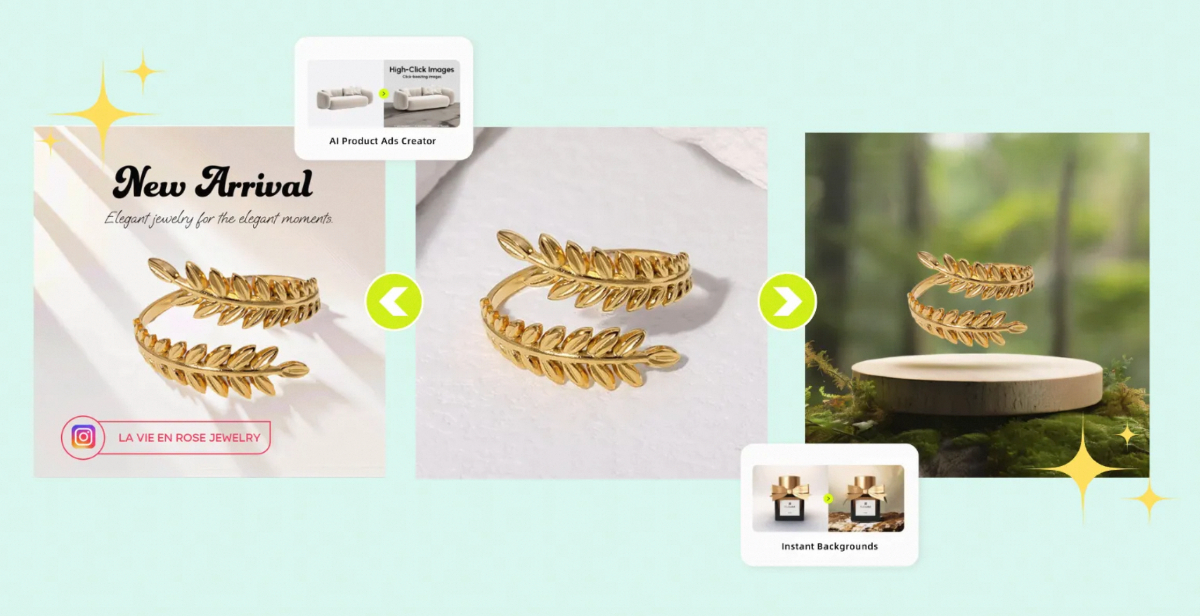
Pic Copilot is just perfect for creating appealing instagram post
(Pic Copilot features tens of thousands of templates designed by premium global designers, updated weekly. The template for the above picture can be found here: https://www.piccopilot.com/template/833)
By leveraging the advanced capabilities of Pic Copilot, such as the AI Product Ads Creator and Instant Backgrounds, you can create stunning, professional-quality images that enhance your product listings, strengthen your brand, and significantly boost conversion rates. This makes Pic Copilot an indispensable tool for your online jewelry business.
Tips for Writing Compelling Product Descriptions
- Detailed Information: Provide comprehensive details about the product, including materials, dimensions, weight, and any unique features.
- Storytelling: Share the story behind the piece, such as the inspiration for the design, the crafting process, or the significance of the materials used.
- SEO Optimization: Use relevant keywords naturally in the description to improve search engine visibility.
- Customer Benefits: Highlight the benefits and advantages of owning the piece, such as its versatility, durability, or uniqueness.
- Call to Action: Encourage customers to make a purchase by including a compelling call to action, such as “Add to Cart” or “Buy Now.”
AI Tools for Social Media Post Creation
Tool | Description | Features | Pros |
ChatGPT | An AI language model that can help create engaging social media posts, captions, and marketing content tailored to your brand’s voice and audience. | Generates creative and relevant content based on input prompts; Can mimic different writing styles and tones; Provides ideas for posts, hashtags, and captions. | Saves time, ensures consistent branding, enhances engagement with high-quality content. |
An AI content creation tool designed to generate high-quality marketing copy, including social media posts, blog content, and product descriptions. | Customizable templates for various types of content; SEO-friendly content generation; Integration with popular marketing platforms. | Versatile, easy to use, improves content creation efficiency. |
These tools can significantly enhance your content creation process, ensuring that your social media presence is both consistent and engaging.
7. Building a High-Impact Marketing Strategy
Social Media Marketing
In the evolving digital landscape, social media platforms play a crucial role in marketing and customer engagement. We recommend focusing on the following three platforms for your jewelry business:
- What is Instagram?
- Instagram is a visually-driven platform ideal for showcasing jewelry with images, videos, and stories.
- How can you leverage Instagram for marketing jewelry?
- Use high-quality images and videos to highlight the intricate details of your jewelry. Utilize stories to share behind-the-scenes content and engage with your audience through polls and questions.
- What are the benefits of using Facebook for marketing?
- Facebook offers a wide range of tools for targeting specific audiences and engaging with customers through posts, ads, and groups.
- How can Facebook be used to enhance jewelry marketing?
- Create targeted ads to reach specific demographics. Engage with customers through posts and groups, and use Facebook Live to showcase new products and host Q&A sessions.
- Tiktok
- Why is TikTok a valuable platform for jewelry marketing?
- TikTok is popular for short, engaging videos that can quickly go viral and reach a younger demographic.
- What strategies can be used on TikTok to market jewelry?
- Create catchy, short videos showcasing your jewelry, participate in trending challenges, and collaborate with TikTok influencers to expand your reach.
- How does Pinterest serve as a platform for jewelry marketing?
- Pinterest is a visual discovery platform where users search for inspiration and ideas, making it perfect for jewelry displays.
- What are effective ways to use Pinterest for jewelry marketing?
- Pin high-quality images of your jewelry to various boards, create themed collections, and use keywords effectively to increase visibility in searches.
Using Influencers and Collaborations
- Partner with Influencers: Collaborate with influencers who align with your brand values and have a following that matches your target audience. Influencers can help showcase your jewelry through authentic endorsements, increasing brand visibility and trust.
- Content Collaboration: Work with influencers to create content such as unboxing videos, styling tips, and product reviews. This not only builds credibility but also engages their followers effectively.
- Events and Giveaways: Host events or giveaways in collaboration with influencers to increase engagement and attract new followers to your brand.
Email Marketing and Newsletters
- Build and Segment Email Lists: Target specific customer groups with personalized offers and updates.
- Create Compelling Campaigns: Highlight new collections, special promotions, and exclusive content in your emails.
- Engage with Newsletters: Keep your audience engaged with valuable information, stories about your brand, and product updates.
Content Marketing and SEO Strategies
- Create High-Quality Content: Develop blog posts, guides, and articles that provide value to your audience and establish your brand as an authority in the jewelry market.
- SEO Optimization: Use relevant keywords, optimize meta descriptions, and ensure your content is structured for search engine visibility.
- Consistent Posting: Regularly update your blog and social media channels with fresh content to keep your audience engaged and improve search rankings.
Paid Advertising
Ad Type | Description |
Google Ads | Use Google Ads to target specific keywords and appear in search results, driving traffic to your site. |
Facebook Ads | Create targeted ads on Facebook to reach specific demographics, interests, and behaviors. |
Retargeting | Implement retargeting campaigns to re-engage visitors who have previously interacted with your site or products. |
By leveraging these strategies and tools, you can build a high-impact marketing plan that drives engagement, boosts sales, and strengthens your brand’s presence in the online jewelry market.
8. Customer Service and Building Loyalty
Building a Loyalty Program
A structured program that rewards customers for their repeat business and engagement. Loyalty programs are designed to create a sense of belonging among customers and incentivize them to continue purchasing from your brand.
Benefits:
- Encourages Repeat Purchases: Customers are more likely to return and make additional purchases if they know they will be rewarded.
- Increases Customer Retention: Loyalty programs help in retaining existing customers by making them feel valued and appreciated.
- Strengthens Customer Relationships: By engaging with your customers through a loyalty program, you can build a stronger connection and foster long-term loyalty.
Examples:
- Points-Based Systems: Customers earn points for every purchase, which can be redeemed for discounts, free products, or other rewards. For example, "Earn 1 point for every $1 spent. Collect 100 points to receive a $10 discount."
- Tiered Rewards: Different levels of rewards based on customer spending. The more they spend, the higher the tier and the better the rewards. For instance, "Silver, Gold, and Platinum tiers with increasing benefits."
- Exclusive Member Benefits: Offer special perks for loyalty program members, such as early access to new products, special sales, birthday discounts, and exclusive events.
Implementation Tips:
- User-Friendly Sign-Up Process: Make it easy for customers to join your loyalty program by simplifying the sign-up process.
- Clear Communication: Clearly explain how the program works, the benefits, and how customers can earn and redeem rewards.
- Consistent Engagement: Regularly update members on their points balance, new rewards, and exclusive offers through emails or app notifications.
Collecting and Utilizing Customer Reviews
Gathering feedback and reviews from customers is essential for building trust, improving your products, and enhancing your brand's credibility. Customer reviews provide valuable insights into what your customers like and what areas need improvement.
Benefits:
- Enhances Credibility: Positive reviews from real customers build trust and reassure potential buyers about the quality of your products.
- Provides Social Proof: Seeing other customers' positive experiences can influence potential buyers' decisions and increase their confidence in purchasing from you.
- Offers Insights for Product Improvement: Reviews highlight what customers appreciate and what can be improved, allowing you to make necessary adjustments to enhance your products and services.
Strategies:
- Encourage Reviews Through Follow-Up Emails: After a purchase, send a follow-up email requesting the customer to leave a review. Make it easy for them by providing a direct link to the review page.
- Example Email Script: "Thank you for your recent purchase! We hope you love your new jewelry. Could you take a moment to share your experience by leaving a review? Your feedback helps us improve and lets others know about our products."
- Offer Incentives: Provide small incentives, such as discount codes or entry into a giveaway, to encourage customers to leave reviews.
- Example: "Leave a review and receive 10% off your next purchase!"
- Display Reviews Prominently on Your Website: Show customer reviews on product pages to help potential buyers make informed decisions.
- Example: "See what our customers are saying about this product below!"
Implementation Tips:
- Automate Review Requests: Use e-commerce platforms and plugins to automate review request emails, ensuring consistent and timely follow-ups.
- Respond to Reviews: Show appreciation for positive reviews and address any concerns raised in negative reviews to demonstrate your commitment to customer satisfaction.
- Highlight Top Reviews: Feature the best reviews on your homepage or in marketing materials to showcase your products' positive feedback.
By effectively building a loyalty program and leveraging customer reviews, you can enhance customer satisfaction, improve your product offerings, and foster long-term relationships with your customers, ultimately driving sales and growth for your online jewelry business.
Related Posts
AR Jewellery: The Complete Guide 2024
FAQs
1. Why should I sell jewelry online? Selling jewelry online allows you to reach a global audience, reduce overhead costs, and provide customers with the convenience of shopping from anywhere. With the growing popularity of e-commerce, it's an excellent opportunity to expand your business.
2. How do I identify the right niche for my jewelry business? Consider popular niches such as affordable fashion jewelry, body jewelry, plated jewelry, handmade jewelry, fine jewelry, vintage jewelry, and fair trade jewelry. Use tools like Google Trends, social media platforms, and competitor analysis tools to understand market trends and customer preferences.
3. Which e-commerce platform should I use to set up my online jewelry store? Popular e-commerce platforms include:
- BigCommerce: Scalable and flexible, with advanced SEO capabilities.
- Shopify: User-friendly, with extensive plugins and integrations.
- WooCommerce: Highly customizable for WordPress users.
- Etsy: Ideal for handmade, vintage, and unique items.
4. What tools can help generate high-quality images for my jewelry?
- Pic Copilot: Developed by the Alibaba design team, Pic Copilot is an AI-powered tool specifically designed for e-commerce. It helps create stunning, professional-quality images and includes features like AI Product Ads Creator and Instant Backgrounds, which are perfect for creating appealing social media posts.
5. What are some effective pricing strategies for jewelry?
- Cost-Plus Pricing: Add a markup to the total cost of production.
- Value-Based Pricing: Set prices based on perceived value to the customer.
- Competitive Pricing: Price your products based on competitors' pricing.
 Essai Virtuel
Essai Virtuel Changement de modèle IA
Changement de modèle IA Vidéos de Mode
Vidéos de Mode Vidéos de Produits en Main
Vidéos de Produits en Main Produit en main
Produit en main Essai D’Accessoires Virtuel
Essai D’Accessoires Virtuel Générateur d'arrière-plan AI
Générateur d'arrière-plan AI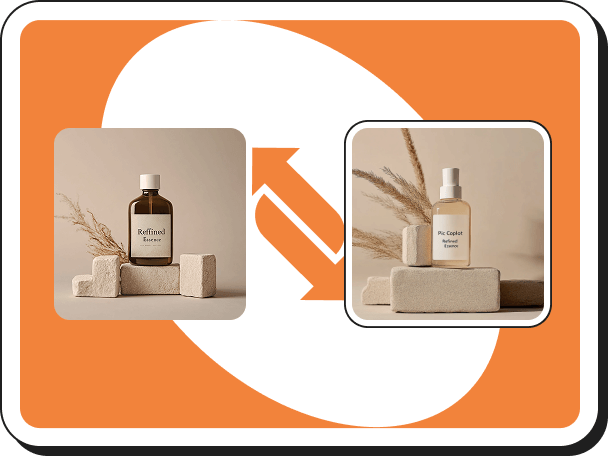 Clone de style
Clone de style Supprimer le filigrane
Supprimer le filigrane Modèles d'IA
Modèles d'IA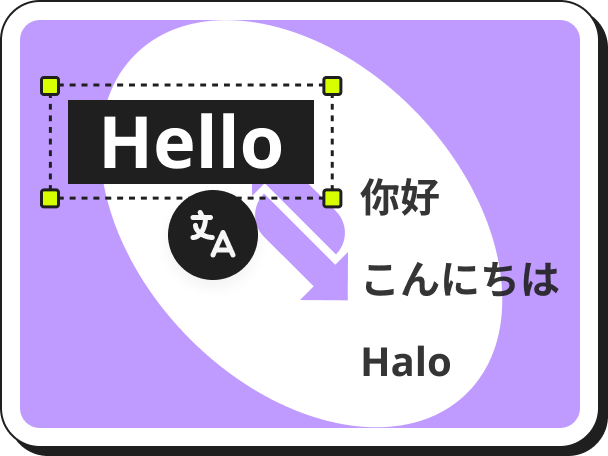 Traducteur d'images
Traducteur d'images Traduction vidéo
Traduction vidéo Essayage Virtuel de Chaussures
Essayage Virtuel de Chaussures Annonceur IA pour les numéros
Annonceur IA pour les numéros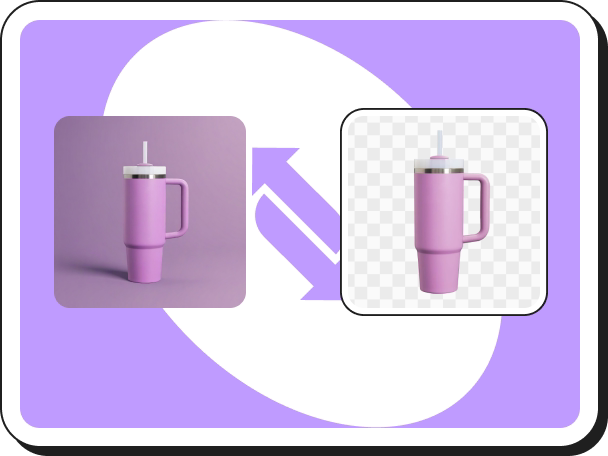 Supprimer l'arrière-plan une fois
Supprimer l'arrière-plan une fois Ombres IA
Ombres IA Agrandisseur d’Images
Agrandisseur d’Images Améliorateur d’Images
Améliorateur d’Images